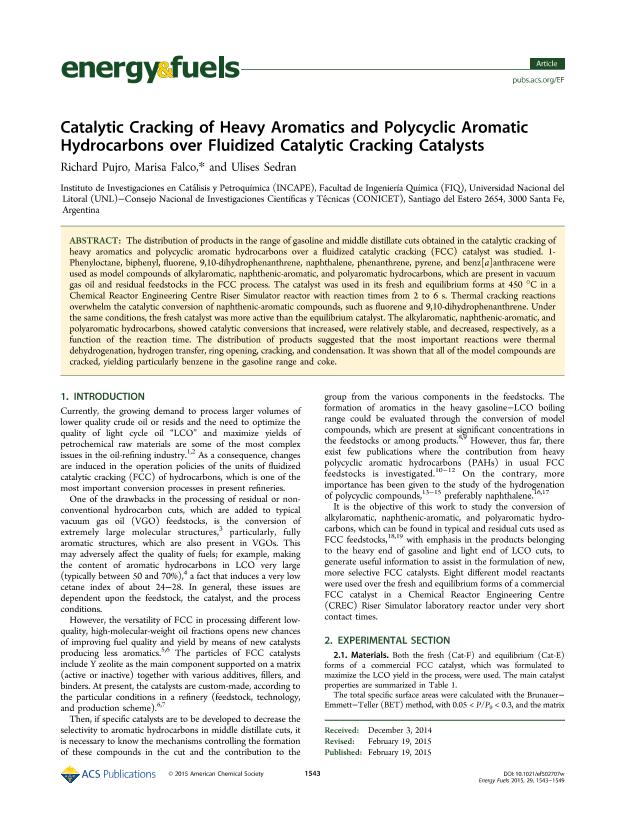Artículo
Catalytic Cracking of Heavy Aromatics and Polycyclic Aromatic Hydrocarbons over Fluidized Catalytic Cracking Catalysts
Fecha de publicación:
02/2015
Editorial:
American Chemical Society
Revista:
Energy & Fuels (print)
ISSN:
0887-0624
Idioma:
Inglés
Tipo de recurso:
Artículo publicado
Clasificación temática:
Resumen
The distribution of products in the range of gasoline and middle distillates cuts obtained in the catalytic cracking of heavy aromatics and polycyclic aromatic hydrocarbons over a FCC catalyst was studied. 1-Phenyloctane, biphenyl, fluorene, 9,10-dihydrophenanthrene, naphthalene, phenanthrene, pyrene and benz[a]anthracene were used as model compounds of alkylaromatic, naphthenic-aromatic and polyaromatic hydrocarbons which are present in VGO and residual feedstocks in the FCC process. The catalyst was used in its fresh and equilibrium forms at 450 ºC in a CREC Riser Simulator reactor with reaction times from 2 to 6 s. Thermal cracking reactions overwhelm the catalytic conversion of naphthenic-aromatic compounds such as fluorene and 9,10-dihydrophenanthrene. Under the same conditions, the fresh catalyst was more active than the equilibrium catalyst. The alkylaromatic, naphthenicaromatic and polyaromatic hydrocarbons, showed catalytic conversions which increased,were relatively stable and decreased, respectively, as a function of reaction time. The distribution of products suggested that most important reactions were thermal dehydrogenation, hydrogen transfer, ring opening, cracking and condensation. It was shown that all the model compounds are cracked, yielding particularly benzene in the gasoline range and coke.
Palabras clave:
Aromatics
,
Pah
,
Lco
,
Gasoline
,
Fcc
Archivos asociados
Licencia
Identificadores
Colecciones
Articulos(INCAPE)
Articulos de INST.DE INVEST.EN CATALISIS Y PETROQUIMICA "ING. JOSE MIGUEL PARERA"
Articulos de INST.DE INVEST.EN CATALISIS Y PETROQUIMICA "ING. JOSE MIGUEL PARERA"
Citación
Pujro Tarquino, Richard Alfonzo; Falco, Marisa Guadalupe; Sedran, Ulises Anselmo; Catalytic Cracking of Heavy Aromatics and Polycyclic Aromatic Hydrocarbons over Fluidized Catalytic Cracking Catalysts; American Chemical Society; Energy & Fuels (print); 29; 3; 2-2015; 1543-1549
Compartir
Altmétricas




